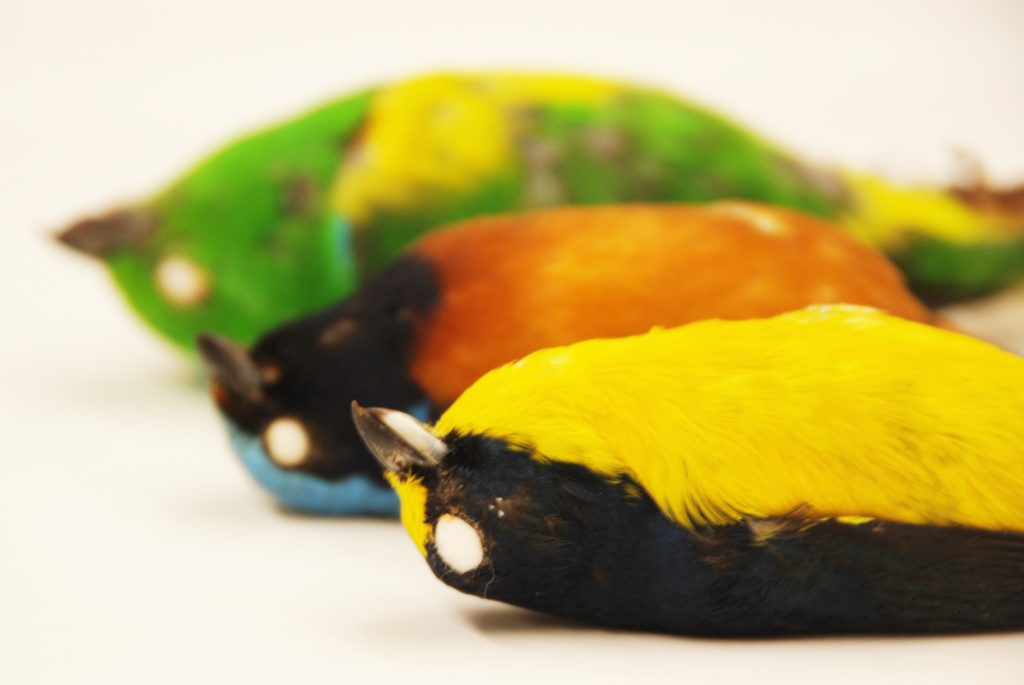By Tyler Imfeld
Linked paper: Mitochondrial genomes and thousands of ultraconserved elements resolve the taxonomy and historical biogeography of the Euphonia and Chlorophonia finches (Passeriformes: Fringillidae) by T.S. Imfeld, F.K. Barker, and R.T. Brumfield, The Auk: Ornithological Advances.
In the first year of my PhD, I spent a lot of time studying the phylogenetics literature to spark ideas for research into the diversification of songbirds in the Americas. I found that, over the last twenty years or so, a tremendous international research effort has resolved relationships within and among practically all of the songbird groups in North or South America, except for one: the charismatic Euphonia and Chlorophonia finches. The 27 euphonias and 5 chlorophonias are small, colorful finches that inhabit forests and woodlands from Mexico to Brazil as well as much of the Caribbean. Many of these species are fruit-eating specialists — the diets of some species, like the Golden-rumped Euphonia are comprised almost entirely of mistletoe fruits!
This group has experienced 20 years of tumultuous taxonomic changes. Ornithologists originally classified euphonias and chlorophonias with tanagers in the family Thraupidae before molecular work in the late 1990s showed that they are actually finches and belong in Fringillidae alongside siskins, goldfinches, and their allies. The most complete study to date (with only 10 of the 32 species) wasn’t completed until 2012, with essentially nothing else before or since! That study showed that some species currently classified as euphonias are actually more closely related to chlorophonias than to other euphonias. Seeing this as a great opportunity to learn modern methods of molecular systematics and fill this gap in our knowledge of songbird diversity, I teamed up with my advisor, Keith Barker, and our colleague, Robb Brumfield, to work on a complete family tree for these birds. We didn’t know it at the time, but this work would uncover new support for the importance of continental movements in bird diversification and would ultimately bring up even more questions about the taxonomy of euphonias and chlorophonias.

We extracted DNA from tissue specimens and study skins from six natural history collections across the country, representing every described species in this group. We then used next-generation techniques to generate 40 billion base pairs of sequence data that included nearly 5,000 loci from the nuclear genome and near-complete mitochondrial genomes for every species. One of the most amazing outcomes of our study was that, regardless of how much of this data we included or how it was analyzed, we obtained consistent, robust relationships within and among euphonias and chlorophonias. Interestingly, our inferred relationships within these genera differed only slightly from a classification proposed by Isler and Isler in 1999 based on similarities in plumage, voice, and habitat, prior to the age of molecular phylogenetics. In agreement with the 2012 study, we found that all three species of blue-hooded euphonias are more closely related to the vibrant green chlorophonias than to other euphonia species. We considered a few options for resolving this taxonomic conflict, but ultimately settled on resurrecting the genus Cyanophonia — created in 1851 at the same time as Chlorophonia — for these blue-hooded species.
With a solid phylogeny in hand, we also wanted to understand the evolutionary origins of this group. Euphonia, Chlorophonia, and Cyanophonia form a subfamily, Euphoniinae, that diverged from the rest of the finches nearly 14 million years ago, but we inferred that the last common ancestor of these species existed only 7 million years ago. By modeling alternative scenarios for range expansion, we found that this group likely dispersed from Eurasia or Africa into South America during this 7 million year window and then independently dispersed twice into the Caribbean and 6 times into North America. These south-to-north dispersal events all occurred around 2 to 4 million years ago and lend support to a younger geological timeframe for the formation of the Isthmus of Panama than argued by some other recent studies.
Another exciting result of our study came from the Orange-bellied Euphonia (Euphonia xanthogaster), which has an enormous range in South America and comprises several subspecies with distinct plumage. We sampled two of these subspecies and found them to be more genetically divergent from one another than some other well-recognized species are to one another. This finding means, in addition to providing concrete suggestions for taxonomic revisions and adding additional support for major inter-American interchange of birds around 3 million years ago, our project has shown that there is likely species-level diversity within these finches still waiting to be described. Excitingly, it appears as though the systematic study of this delightful group of finches has only just begun.

Several decades ago I kept a few different kinds and had a successful nesting by Chlorophonia occipitalis in an outdoor flight in Los Angeles.
They were charming and their call was lovely. I wish they were established in US zoological collections. Others I kept at different times included a single male Thick-billed Euphonia with a personality like a red headed barbet and a pair of very small and quite drab colored Bronze-green Euphonia .
What a lovely personal recollection of the way this study developed; I wish more science reading was so enjoyable!